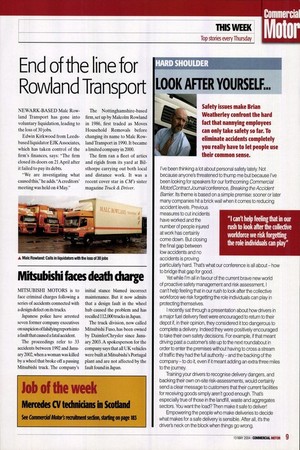LOOK AFTER YOURSELF...
Page 9

If you've noticed an error in this article please click here to report it so we can fix it.
Safety issues make Brian Weatherley confront the hard fad that nannying employees can only take safety so far. To eliminate accidents completely you really have to let people use their common sense. I've been thinking a lot about personal safety lately. Not because anyone's threatened to thump me but because I've been looking for speakers for our forthcoming Commercial MotorlContract Journal conference, Breaking the Accident Barrier. Its theme is based on a simple premise: sooner or later many companies hit a brick wall when it comes to reducing accident levels. Previous measures to cut incidents have worked and the number of people injured at work has certainly come down. But closing the final gap between low accidents and no accidents is proving
particularly hard. That's what our conference is all about—how to bridge that gap for good.
Yet while I'm all in favour of the current brave new world of proactive safety management and risk assessment, I can't help feeling that in our rush to look after the collective workforce we risk forgetting the role individuals can play in protecting themselves. I recently sat through a presentation about how drivers in a major fuel delivery fleet were encouraged to return to their depot if, in their opinion, they considered it too dangerous to complete a delivery. Indeed they were positively encouraged to take their own safety decisions. For example, if that meant driving past a customer's site up to the next roundabout in order to enter the premises without having to cross a stream of traffic they had the full authority — and the backing of the company —to do it, even if it meant adding an extra three miles to the journey
Training your drivers to recognise delivery dangers, and backing their own on-site risk-assessments, would certainly send a clear message to customers that their current facilities for receiving goods simply aren't good enough. That's especially true of those in the landfill, waste and aggregates sectors. You want the load? Then make it safe to deliver!
Empowering the people who make deliveries to decide what makes for a safe delivery is sensible. After all, it's the driver's neck on the block when things go wrong.




















































































































































































































